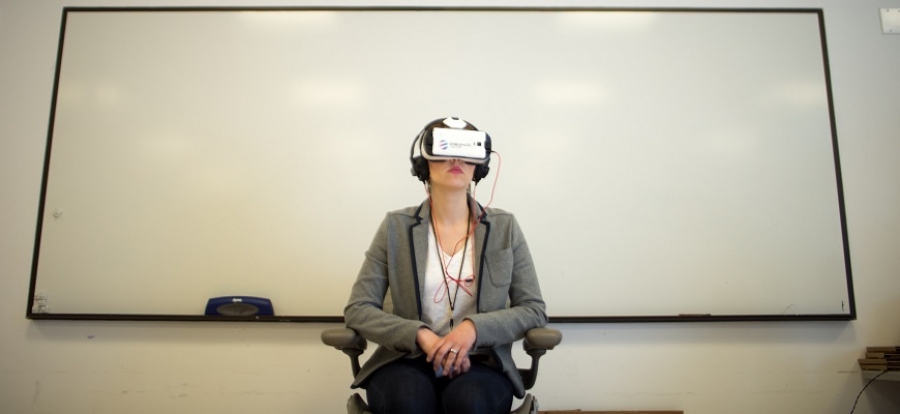Realising the immediate need for virtual field visits to meet the demand of the new linear GCSEs, together with Nathan ‘@Nathanashman’ Ashman, we’ve created a 360° VR experience (generally referred to as just “360”) based around the Elizabethan England Depth Study. This initial offering focuses on the 2018 AQA-nominated site Hardwick Hall in Derbyshire, and we have been thrilled with the response! Since the site will change annually, teachers and students need freshly-created bespoke content aimed at Key Stage 4 students. We adopted the ‘Martini Principle’, creating a 360° experience which gives access for the duration of the course. It’s History; anytime, anyplace, anywhere.
Using 21st century technology, students can be transported back to a 16th century Elizabethan prodigy house through their phones and Google Cardboard headsets. This new teaching tool adds another fresh dimension“Teachers and students need freshly-created bespoke content.” to historical studies, and allows for mobile students to learn at their own pace and act independently. The 360 quickly provides busy teachers an insight into a specific site with which they understandably may not be familiar.
The reality is, when it comes to historical sites, actual visits may not always be possible - depending on cost and geographical constraints. That’s where virtual visits will be an important option, and schools can dip in and out of using the technology. Brendan Walker, professor of creative industries at Middlesex University, contends that VR is social, theatrical, inspires innovation and is democratising by allowing access to experiences by larger groups in different contexts.
Due to the ubiquitous nature of the technology, the wider community can easily be involved. Using shared links and QR codes, family members might be enthused to get to know Bess of Hardwick (‘clarissimarum fabricatrix’), the creator of the Hardwick Hall. Increased participation is happening at Alder Grange School, where the 360 link is to be shared with parents. The hope is that the physical building might be visited, or at least History will be on the agenda at home, meaning these innovative approaches might be discussed at tea time!
The resource was made with the new 16 marker GCSE History exam question in mind. Working backwards from the assessment objectives and criteria, we thought about where best to place emphasis. Hardwick has 46 rooms, so we focused on four in which students could become immersed, letting them get to grips with the decorative detail and 16th century changes which led to Bess’ masterpiece. Footage was filmed using a Theta 360 camera, with the National Trust guidebook and other sources helping with student voice-overs to keep the experience real and accessible. The commentary goes beyond the ‘bricks and mortar’, allowing students to make wider connections to the ideas and values reflected in the site and Bess’ possible motivations. Once the filming was complete the composite 360 was assembled using Thinglink, leading to the finished focused and easy to navigate final experience.
The process and resulting 360 has been showcased at Bett in January 2017 and shared at TM Lancashire in Blackburn, TM History Icons in Chester, courses in Manchester and London, webinars and school visits during the spring and summer terms, TM Moving On Education in Exeter and more. We have been thrilled by the reception from teachers ambitious for their students, and the clear student’s enthusiasm for this new technology.
Virtual and actual visits are not mutually exclusive - in fact, initial case studies from schools during summer term 2017 show both have been used to complement each other. Schools are rightly keen to share and celebrate their successes. At The Mount School in York, head of History Helen Snelson used the 360 before and after a field visit with GCSE students. It was a new departure for them, and students were universally in favour: “It’s fun to go back to Hardwick using the VR”, “I like being able to control where I go”, “It’s great revision for me as I’d forgotten some stuff already”, “I think this will really help me prepare for my exams.”
At Pleckgate High in Blackburn, head of department Martyn Bajkowski embraced a whole-department approach, since the Elizabethan England unit was brand new to his five member teaching team, and he was seeking a consistent“Schools are rightly keen to share and celebrate their successes.” approach for their 150 students. He describes himself as a huge fan of site visits and new technology, so this appeared to be the perfect combination. However he also notes he has seen “fads come and go”, and comments: “I treat new ideas and technologies with a certain professional scepticism. I am focussed on the outcomes it delivers in the classrooms. I have both seen and done some new jazzy spur of the moment teaching craze which in reality turns into an hour-long car crash.”
Here is Martyn’s four stage approach to trialling the Hardwick Hall 360 in the classroom;
Stage 1 – Pencil Outline (Teachers using VR)
“As a team of five we used the VR on our phones through cardboard glasses, and became familiar with the site. We really enjoyed it, and it gave us both a broad understanding of the main areas to cover and confidence to deliver the new content to our students.”
Stage 2 – Broad Brush Strokes (Teacher leading students through VR prior to the trip)
“Having ‘visited Hardwick’. we had the confidence to use the VR with our students. Instead of using phones, we used iPads - our school is fortunate enough to equip each student with them. The students loved it and allowed us to pinpoint key messages and build up an understanding prior to the trip.”
Stage 3 – Finer Detail – The Trip Itself
“The preliminaries added hugely to the trip itself. Using the VR as a point of reference we were able to explore points in more detail and get added value from the site visit. Having visited Hardwick virtually before, it allowed students to ask the guide more pertinent questions, giving them a deeper understanding.”
Stage 4 – Reflection on the masterpiece (Using VR to consolidate the trip)
“Having gone into depth whilst at Hardwick, we then returned to the classroom to consolidate our learning and focus back on the exam question. We used the VR again in order to help students re-engage with the trip and make connections.
“Overall it was a tremendous success. It enabled our students and staff to prepare for the trip, allowed the trip itself to be more meaningful and purposeful and allowed us to consolidate that learning afterwards.
“The benefits of using this approach are evident. In a 'flipped learning’ style, students can make some preliminary investigations. The 360 can be used to arouse curiosity, encouraging students to open up other enquiries and bring further questions to lessons.”
William Howard School, Poole High School, Ashville College and Darton College amongst others are intending to use the 360 throughout the school year.
Bess of Hardwick, living in the sixteenth century, was a pioneer at the cutting edge. She took risks and knew how to innovate showing off skills with the latest Elizabethan technology in the 1590s. Visitors marvelled at the masterpiece that is ‘More window than wall’. Spirited 21st century teachers now are bravely following in her footsteps.
Want to receive cutting-edge insights from leading educators each week? Sign up to our Community Update and be part of the action!


















